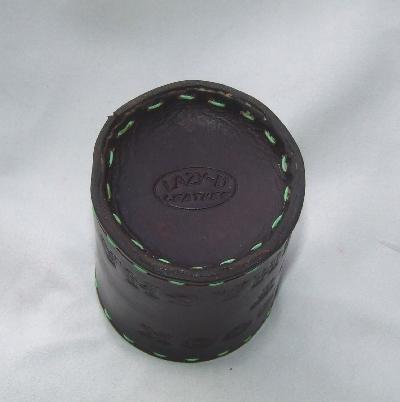-
Posts
5,928 -
Joined
Content Type
Profiles
Forums
Events
Blogs
Gallery
Everything posted by fredk
-
For the odd time I've had to burn off a thread I use a wood cocktail stick lit up by a tea-light candle. I often have one of those scented tea-light candles burning nearby.
-
When I made a dice cup with inset bottom I punched the holes for the sides. glued the bottom up into place then used a round awl to punch each hole through as I came to it (actually I did about 6 holes at a time) I know its not great work
-
Properly done even a basic sealer will make it keep its shape. It needs a real long term soaking and mushing about for wet-moulded leather to loose its shape A real good sealer I'm using more and more is the acrylic varnish sold as 'Pledge Floor Gloss'
-
no, it was a top gears cover to lower cover / engine nose / engine and also a dynamo mounting to the top gears cover
-
Note. Off topic. Just to answer queries We did the first 1/4" bolt into M6 helicoils fitting by accident. We had two parts bolted together, one had threaded through holes and the other had threaded blind holes. The design of the parts is that the bolt is screwed part way through first part, the part offered up to the second part and the bolts run up tight. There are short locating sleeves to help with alignment so the first few mm of the hole in second part has no thread 1. we had through holes with near stripped 1/4 inch threads 2. I drilled out and ran M6 helicoils into the through holes. Intention was to put M6 helicoils into the blind holes as well. But I held off as changing to M6 was going to compromise the part. 3. No.1 son accidently took the 1/4 inch bolts and bolted the two parts together thinking I'd finished and all was ready for re-assembly. 4. when we realised what we'd done we took some bolts out and checked and they needed unscrewing their whole length 5. We used this same process on purpose on a few other 1/4 inch bolt threads. I think the threads on the 1/4 inch were British Whitworth, just slightly off from M6. The helicoil, by its nature of being a coiled spring can expand slightly to accommodate the difference.
-
Just as a note for others looking in. Helicoils, some of, can adapt to the thread. eg. I/we fitted some M6 Helicoils into some drilled holes and screwed 1/4 inch bolts into them on my 1930 Austin . It wasn't an option to change fully to M6 bolts
-
yes, I keep a a sewing needle in a pin drill chuck just for the purpose of clearing that hole
-
Drill it out to M7 and fit M6 helicoils
-
I've been watching old episodes of the TV show 'Highway Patrol' I've noticed that in some episodes the officers use an unusual holster. It looks like a regular revolver holster, but it has the ability to hinge open, the hinge being at the trigger guard side and the opening on the barrel side. I thought it might be a special made just for one actor for this show but this type of holster appears in many scenes across the 4 years of the show and many of the officers, even the small part ones use it. I've linked a bit of a Highway Patrol episode on youtube where the opening of the holster can be seen clearly, between 22.05 and 22.20 mainly. btw, all the leather work on this programme has loverly basketweave tooling Not being a holster maker I thought to put it here and get comments from those of you who do make holsters. Like, how do you think its made?, have you ever come across this type of holster before?
-

Tippman Boss sewing machine for sale new in box
fredk replied to Brittanycrystal's topic in Old/Sold
Considering the OP hasn't been on here since September 20th 2020 and only made the one posting I doubt she's really interested -
a quick fix to reduce the plasticky look. get some blocks of pure bees' wax. From a hardware store. Just the blocks of wax, no fancy 'leather finish' stuff. Put the wax in or on a heat proof bowl/plate. Warm it up until its soft. Then use a cloth to apply the beeswax to the leather and rub it in. Allow to cool down and harden, then use another clean cloth to buff the wax. If you have any, apply pure neetsfoot oil, aka NFO, to the leather, Work the leather in your hands for a while, this should soften it up a bit. A better solution, for later, is to make a beeswax, carnauba wax and neetsfoot oil mix and apply that as a top finish Why Olive Oil? Long term it does nothing good to the leather. Leather is an animal product, olive oil comes from plants, Use neetsfoot oil, (aka NFO) which is made from the oils and fats in the feet and lower legs of cattle. Animal product to animal product. When you tool leather et cetera you remove some of the natural oils from the leather. Replace them with NFO. Olive oil doesn't replace those natural oils. btw, on here we usually recommend you use pure NFO and not compound. The compound has petroleum distillates in it which may be detrimental to the leather. Stitching holes; as early in the project as I can, sometimes before dyeing if its possible. Sometimes its almost the last stage in a construction, It all comes down to the project. Experience will help tell you when. But, at almost all times, consider where your stitching will be and mark a line for that, it can be a pencil line or a stitching-groove. On your first skull picture it looks like you punched holes after the tooling (?) On the second skull it looks like you have not made allowance for any stitching, but you could stitch in the groove which is the skull outline. Edge finishing; again depends on the project. On your belt, it would be the last thing I would do just before fitting the buckle. If the skull pieces are to be applied to something, like a bag flap, then they need dyed, top-coated and edges done before applying to the bag. If you were to make a bag with a front piece, a gusset and a back piece, finish the edges when all three pieces are stitched together hth
-
If no-one can give you an answer here's a wee trick I used to use. Used both on ebay and live auctions. Put the item up for sale, but with a ridiculously high 'reserve; price, like $1 million. People will bid to the highest they think its worth, most likely well below your reserve. Then you'll have a guide price to what its worth. There is a chance that someone will meet your reserve price and you may need to sell
-

Tree of Life Bifold
fredk replied to AndyL1's topic in Purses, Wallets, Belts and Miscellaneous Pocket Items
oh, that is just beautiful echo; how did you do the Tree? Nosey, err . . . enquiring minds want to know these things -

First Kindle cover
fredk replied to Akers's topic in Purses, Wallets, Belts and Miscellaneous Pocket Items
off-topic. yes there was. It says something like, 'fit that suicide-jockey behind that micro-bus full of friends of Jesus, he's hauling dynamite and can use all the help he can get' In N.I. we used our own lingo. Suicide-jockey = a mad motorcyclist -

First Kindle cover
fredk replied to Akers's topic in Purses, Wallets, Belts and Miscellaneous Pocket Items
Thanks. My cb handle was 'suicide-jockey'. Try getting an image to represent that! -

First Kindle cover
fredk replied to Akers's topic in Purses, Wallets, Belts and Miscellaneous Pocket Items
Thats nice. It looks well thought out, plenty of pockets. Any special reason for the chess knight design? #I keep meaning to make a cover for my KOBO. Someday, maybe, perhaps. . . -

Tom Threepersons holster.
fredk replied to AA3JW's topic in Gun Holsters, Rifle Slings and Knife Sheathes
I see that as a personal choice Do you want an 'historically' accurate holster? or a holster with a modern safety feature? -
I've not come across a self-healing cutting mat without the grid lines But do shop around. You'll pay for the 'name' on the mat, eg I can buy an Olfa 'named' mat for about £25 or a 'no name' one from my resins suppliers for £7. Yes, they do have slightly different construction but in the end they work just the same As said above, buy to suit what you make, not too big nor too small. I have ones 3 inches square for trimming corners on and up to A0 size, approx 33 x 47 inches, but my most used size is 45 x 60cm approx 17 x 24 inches. If you are making just small things you can get an A4 size, approx 8 x 11 inches for as little as a couple of $$
-
no, that doesn't work for us mortals
-

Mock croc and nubuck back pack
fredk replied to Bogwot's topic in Purses, Wallets, Belts and Miscellaneous Pocket Items
That looks just grand so it does Does that lower strap arrangement give good support? I imagine it does, looks better than straps coming up off the bottom- 5 replies
-
- made in uk
- backpack
-
(and 1 more)
Tagged with:
-
1. Its worth what anyone is willing to pay 2. as a bit of a guide. About 4 years, maybe 5 years now, I bought a 1950s 99K with fitted electric motor. Its in near mint condition, lower wood case but no top cover. I paid about £180 for it, fully serviced & rebuilt with a 1 year guarantee and servicing/repair deal. Old 99Ks without electric motors generally sell for as low as £15, with a full wood case
- 1 reply
-
- hand machine
- singer
-
(and 1 more)
Tagged with:
-
If you want to go tubes Go to a carpet shop and ask for their card tube inners. They have to dump them so they may give them to you for the taking away The tubes are often about 4 to 6 inches inside diameter and 12 to 14 feet long, so take a saw with you . You can cut them down to suit whatever length you want them to be. Before I switched to the plastic boxes thats what I used. I got a load of long tubes and spent ages in the carpet shop carpark cutting the tubes down just to fit in my car. The deal on the day was, take them all or none. I took about half the load to the recycling, half of what was left to a friend for packaging and I still had more than enough for my needs easy ways to know whats in the tube 1. make the tube shorter than the roll, or don't push it all the way in 2. write on the tube whats in it. and up-date that note every time you use some of that leather
-
Currently almost all my heavy leather is rolled and stored in plastic 'Christmas tree boxes' stacked in my back hallways. Thin soft leather is folded and stored in plastic or card boxes, stacked where there is somewhere to stack them



